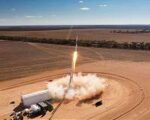Boeing has officially launched a new family of tiltrotor combat drones designed to combine the vertical lift advantages of helicopters with the speed and range of fixed-wing aircraft. Revealed in October 2025, the concept signals Boeing’s strategic push into advanced Group 5 unmanned aerial systems (UAS) for multi-domain operations. The platform is tailored for long-range ISR-strike missions and expeditionary support under contested airspace conditions.
Boeing’s Tiltrotor UAS Concept: Bridging Rotary and Fixed-Wing Capabilities
The newly unveiled tiltrotor drone family is based on a scalable architecture that leverages Boeing’s decades-long experience with rotorcraft and unmanned systems. The concept features twin rotating nacelles similar to those on the V-22 Osprey or Bell V-280 Valor but optimized for unmanned operations. While Boeing has not disclosed exact specifications yet, renderings suggest a medium-to-large platform with stealth shaping and internal payload bays.
According to Boeing officials quoted by multiple defense outlets including Breaking Defense and Janes Defence Weekly (Oct 2025), the drone is intended to perform missions such as:
- Long-endurance ISR (Intelligence, Surveillance & Reconnaissance)
- Precision strike with air-to-ground munitions
- Electronic warfare support
- Communications relay in denied environments
- Logistics resupply in austere or contested areas
The design appears modular and may support both autonomous operations and remote piloting via satellite or line-of-sight links. Boeing emphasized that the system will be able to integrate into joint all-domain command-and-control (JADC2) networks.
Strategic Context: Competing in the Future Vertical Lift Ecosystem
This launch positions Boeing squarely within the evolving Future Vertical Lift (FVL) ecosystem—a U.S. Army-led initiative seeking next-generation rotorcraft across multiple weight classes. While Bell Textron has dominated recent manned FVL awards (e.g., winning FLRAA with its V-280), Boeing’s unmanned tiltrotor concept could address gaps in Group 5 UAS capabilities for high-speed VTOL platforms.
The system may also align with DARPA’s ANCILLARY program (AdvaNced airCraft Infrastructure-Less Launch And RecoverY), which seeks runway-independent unmanned aircraft capable of operating from ships or unprepared terrain. In this context, Boeing’s offering could compete against Northrop Grumman’s hybrid VTOL designs or Anduril’s Ghost series.
Design Features and Technology Enablers
Though detailed specs remain classified or undeclared as of October 2025, open-source imagery and industry analysis suggest several key features:
- Twin tiltrotors: Allow vertical takeoff/landing while enabling cruise speeds >400 km/h
- Internal weapons bays: Likely supports modular payloads including small diameter bombs (SDBs), loitering munitions, or EW pods
- Stealth shaping: Faceted fuselage suggests radar cross-section reduction efforts
- AUTONOMY stack: Expected to include AI-enabled navigation and target recognition algorithms developed under DoD autonomy initiatives
- C4ISR integration: Designed for seamless data sharing across JADC2 architecture using Link-16 or future waveforms like MADL/IBCS-compatible links
Boeing also hinted at potential naval variants capable of operating from destroyer-class ships without catapults or arrestors—suggesting interest from the U.S. Navy’s Distributed Maritime Operations doctrine.
Pilotless Strike Support: Operational Use Cases Emerging
The operational value proposition centers on contested logistics and ISR-strike missions where traditional drones face runway dependence or limited survivability. Key mission profiles include:
- Austere base resupply: Deliver critical cargo without needing runways or rotary-wing escorts
- Tactical strike enabler: Loiter near frontlines to deliver precision-guided munitions at short notice
- SIGINT/EW platform: Deploy electronic warfare payloads deep into denied zones without risking manned assets
- MUM-T integration: Operate alongside manned aircraft like FARA or FLRAA under manned-unmanned teaming constructs
This aligns closely with evolving U.S. Army doctrine emphasizing dispersed operations across Indo-Pacific scenarios where vertical mobility is critical but risk tolerance for crewed platforms is low.
Boeing’s Broader UAS Strategy and Competitive Landscape
This tiltrotor drone marks a significant evolution in Boeing’s unmanned strategy following earlier programs like MQ-25 Stingray (carrier-based refueler) and Phantom Works’ experimental UAVs such as Phantom Ray. It also reflects growing demand for runway-independent Group V-class drones—especially as peer threats develop anti-access/area denial (A2/AD) systems targeting known airfields.
Boeing will likely face competition from several fronts:
- Northrup Grumman: With its Firebird optionally piloted ISR aircraft and future hybrid-VTOL projects under DARPA funding.
- Korean Air & KAI: Developing large-scale VTOL UAVs for regional defense customers.
- L3Harris & Shield AI: Working on AI-piloted tactical drones capable of complex strike missions without GPS reliance.
If successful in prototyping phases expected through late FY2026–FY2027, Boeing could position this system as a cornerstone of joint force modernization plans through FY2030+ budget cycles.
No Timeline Yet—But Testing Likely Imminent
Boeing has not released firm timelines for flight testing or production milestones but confirmed that wind tunnel testing is complete on subscale models. Full-scale demonstrator construction may already be underway at Phantom Works facilities in St. Louis or Mesa based on procurement filings reviewed by defense analysts at Aviation Week (Oct. ’25).
The company may reveal more details during upcoming events such as AUSA Winter Symposium (Feb ’26) or SOFIC Tampa if special operations variants are planned.
If funded by services like SOCOM or Army Futures Command under rapid prototyping authorities (MTA Pathway Sec804), initial flight tests could begin within CY2026—potentially ahead of any formal program-of-record designation.










